Though separated from us by an ocean of time, scientific pioneers such as Ibn al-Haytham continue to influence the study and practice of optics today.
JOEL WILLIAMS, ASSOCIATE EDITOR
The history of optics traces back to the primitive lenses of the ancient Egyptians and Mesopotamians, the rudimentary logical conjectures of the
ancient Greek philosophers, and the simple geometrical optics of figures
such as Euclid, Ptolemy, and Hero of Alexandria.
Often overlooked in this history are
figures from the Islamic Golden Age, which is generally considered to have spanned the period between the 8th
and 14th centuries, beginning with the overthrow of the repressive apartheid regime of the Umayyad caliphate by the Abbasid Revolution and ending with the Mongol invasions and the siege of Baghdad.
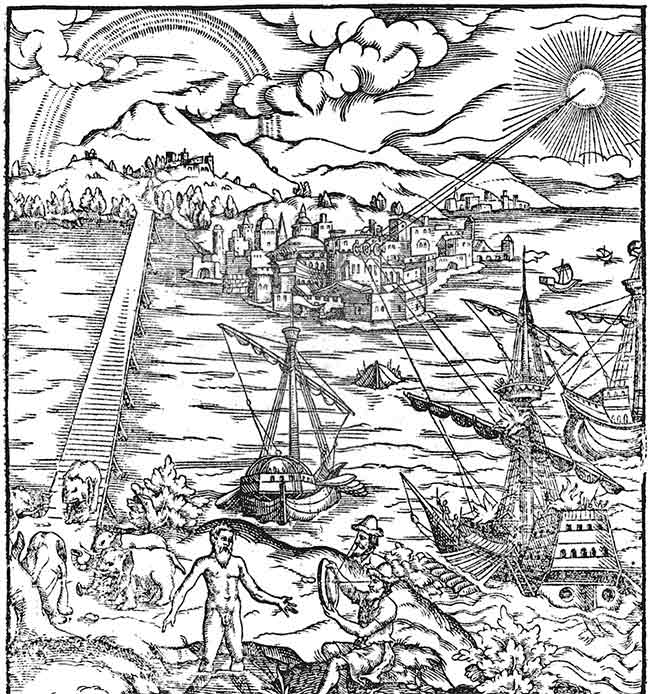
The front page of the Opticae Thesaurus, which features the first Latin translation of Ibn al-Haytham’s Book of Optics in print. The image depicts mirrors, rainbows, and other optical effects. Courtesy of Bavarian State Library.
Out of this period came revolutionary ideas from luminaries such as Abu Ali al-Hassan Ibn al-Haytham, whose Book of Optics laid the foundations for the modern understanding of optics and continues to influence optical theory and design today.
Enlightened age
After the overthrow of the Umayyad regime, Baghdad replaced Damascus as the capital city of the new Abbasid caliphate, which held comparatively more cosmopolitan and egalitarian views. Under the new regime, Arabs, Persians, Christians, Hindus, and others coexisted, traded, and freely exchanged ideas.
In that time, one of the major centers for such exchanges was Bagdad’s House of Wisdom, established by caliph Harun al-Rashid, and later improved by his son and successor al-Mamun. The scholarly destination was modeled after similar
efforts in Damascus and Cairo. There,
important texts — such as Ptolemy’s Optics, and works by Pythagoras, Plato, Euclid, Brahmagupta, Charaka, and
others — were translated.
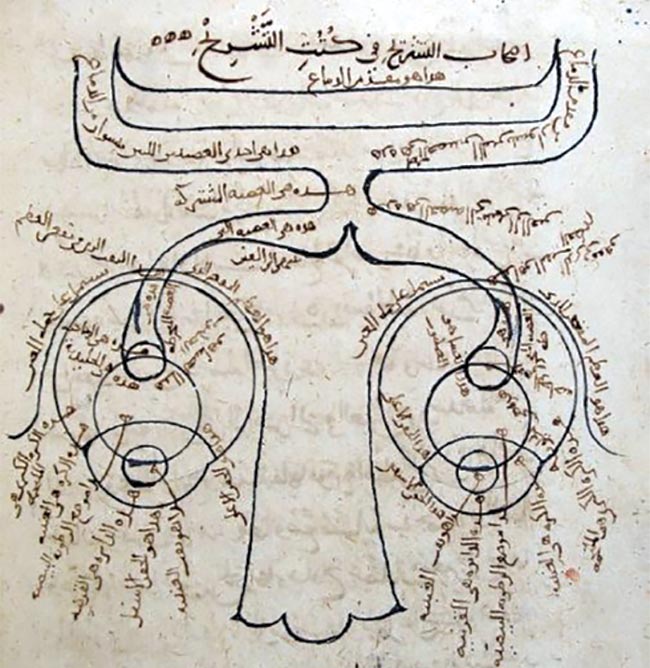
Ibn al-Haytham’s diagram of the structure of the human eye, as found in the Book of Optics. Courtesy of Kitab al-Manazir, Süleimaniye Mosque Library, Istanbul.
“One of the myths about the Golden Age of Islam was that they did the world a service because they preserved what the Greeks did,” author Bradley Steffens said in conversation with Photonics Media. “That was the old reading of them. It was as if they had contributed nothing, but they at least successfully preserved some work. But now we know they not only preserved works, but they commented on them; they took them further,” he said. Steffens is the author of the first full biography written about the Muslim mathematician, called Ibn al-Haytham: First Scientist, and the novel The Prisoner of Al-Hakim, which weaves together historical accounts and stories about Ibn al-Haytham’s life.
Inquisitive thinkers such as Ibn al-Haytham flourished in the more cosmopolitan culture, where he had access to studying a broader range of texts and translations, including Ptolemy’s Optics, which he translated.
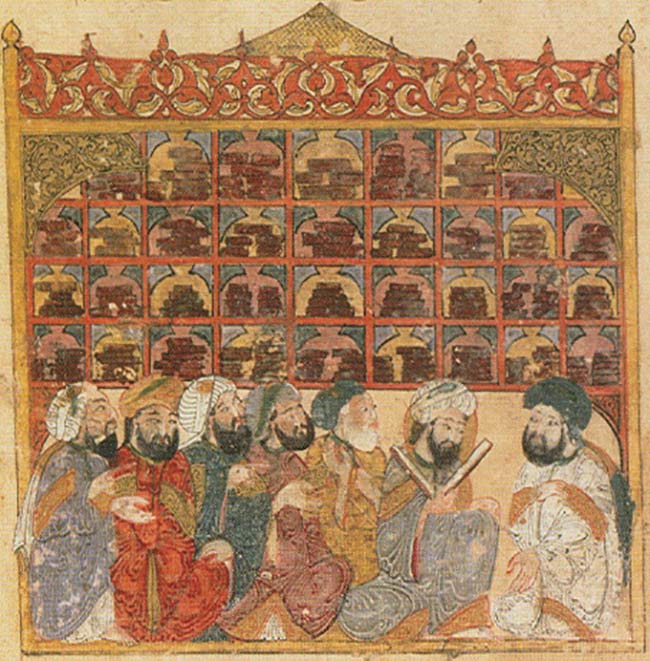
Maqamat of al-Hariri by Yahyá al-Wasiti (1237) depicts an illustration of scholars at an Abbasid library. Courtesy of National Library of France in Paris.
In his early life, Ibn al-Haytham studied religion extensively. His autobiography details his conflicting views of various religious movements, and concludes that none of them represent the truth. Disillusioned with religious studies, he asserted that various ideas and readings came down to sociological and cultural differences.
“So he turns to the Greeks, he turns to mathematics, and he turns to science as a more precise endeavor,” Steffens said.
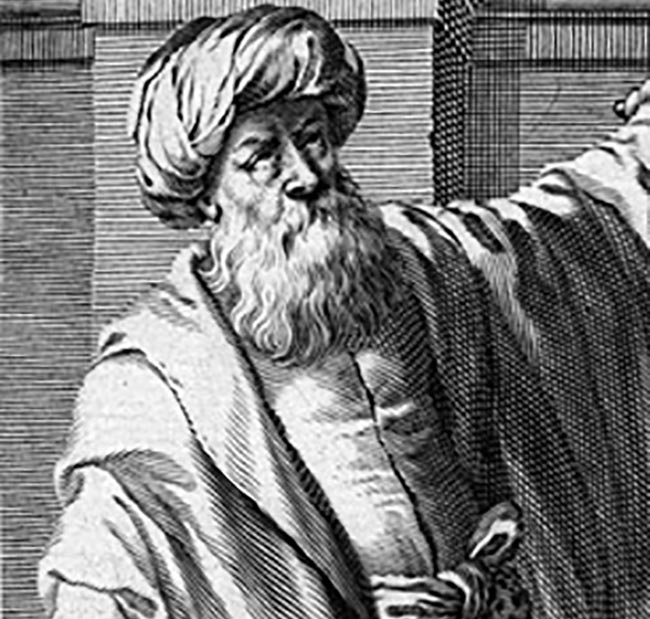
Johannes Hevelius’ depiction of Ibn al-Haytham in the book Selenographia, sive Lunae descriptio (Selenography, or a Description of the Moon). Courtesy of Johannes Hevelius, Selenographia.
Ibn al-Haytham studied the works of Aristotle, Ptolemy, and others, and he wrote a number of critiques of these works, upon which he built his own theories and ideas. From these emerged early applications of scientific methodology that, while less sophisticated than those developed later, demonstrated the process of forming a hypothesis, conducting an experiment, and drawing a conclusion.
Early optics experimentation
The scientific method is clearly evident in Ibn al-Haytham’s most famous work, the Book of Optics, which in its first volume states that his investigation of light will be based on experimental evidence rather than on the abstract theory and conjecture that typified the theories of vision developed by the Greeks.
The Book of Optics shows Ibn al-Haytham to be the first to correctly explain how vision works, though his explanations on the finer details of the structures of the eyes are in error because the function of the eye’s lens had not yet been discovered.
During Ibn al-Haytham’s time, there were two prevailing ideas about vision. The first, the theory of emission, held that every object had an essence that moved through the air and into the eye where it was interpreted through the eye. The second idea assumed the eye sent out rays to perceive objects. The latter concept was championed by mathematicians, though it did not account for certain phenomena such as objects in the distance appearing smaller. Neither did it explain why people could not see in the dark.
Ibn al-Haytham theorized that vision
is enabled by light. While this answered one big question, however, it raised many more. He began experimenting with shining various light sources through tubes in an attempt to determine how light moves, or whether it moves in straight lines or in rays.
“One of the questions he asks is, ‘If there are rays and if they’re coming off of everything all the time, then do they mix in the air?’” Steffens said. “His question was, ‘Do colors and lights mix in the air?’ The obvious answer, he said, was no
because we can see things clearly. But how would you test that?”
Ibn al-Haytham describes his experiments methodically. To test his theories about how light rays moved and interacted, he began by placing three light sources on a table, with a pinhole aperture positioned a certain distance away. On the far wall appeared an image of the three lights. Ibn al-Haytham extinguished his individual light sources and discovered, through the camera obscura he had fashioned, that the image was mirrored; the leftmost light source appeared rightmost on the wall.
“So first he determines that the lights are traveling in straight lines, then that they’re crossing at the aperture, and then that there’s no difference whether one is lit or whether they’re all lit, that they’re not interfering when they cross,” Steffens said. “The reason I think this experiment is so important is that he’s showing all the steps of the scientific method. He doesn’t just reach the conclusion, he then writes about the conclusion and he asks other people to verify the conclusion.”
Despite Ibn al-Haytham’s recorded experimentation with pinhole apertures, the discovery of the how the pinhole camera works is largely credited to Giambattista della Porta, who redescribed the phenomena in his 1558 work Natural Magic.
Visionary for vision
Ibn al-Haytham not only determined some of the basic truths about how light relates to vision, he went further, determining that vision is interpreted in the brain rather than in the eyes. In the third
volume of the Book of Optics, he discusses optical illusions and errors of vision to demonstrate that our vision can be fooled.
“A child who has never seen a camel, seeing a camel at a distance, might think that it’s a person on a horse,” Steffens said. Other historical anecdotes echo this idea, such as those describing natives who had never seen a sailing ship interpreting sails on the horizon to be clouds.
At the beginning of Ibn al-Haytham’s life, little was known or understood about light and vision. By the time of his death, he had discovered truths about vision, light, geometry, astronomy, and more.
The Book of Optics is among the last great surviving contributions of the Islamic Golden Age. Many historians mark the end of the age with the Siege of Baghdad in 1258. Historical accounts of the event describe the Tigris running red with the blood of slain scholars, and later black with the ink of priceless books and treatises that had been torn apart for their leather.
Scholar Nasir al-Din al-Tusi was able to rescue approximately 400,000 texts, which he had brought to Maragheh prior to the siege. This act of heroism preserved many of the scientific and mathematical foundations upon which the world of scientific advancement has been built. His efforts preserved countless works of the scholars of the Abbasid caliphate, allowing them to be transmitted to the Europeans, who built upon the scholars’ efforts. The Book of Optics would remain the definitive textbook on optics for 400 years, studied by Roger Bacon, Leonardo da Vinci, Galileo Galilei, René Descartes, and many more.
Islamic Foundations for Mathematics
The Islamic Golden Age was a boon for the sciences, optics, astronomy, medicine, chemistry, and botany — largely for its advancements in mathematics. Contributions from figures such as Abu Yusuf al-Kindi, Muhammad ibn Musa al-Khwarizmi, and Ibn al-Haytham continue to fuel discoveries made by scientists today.
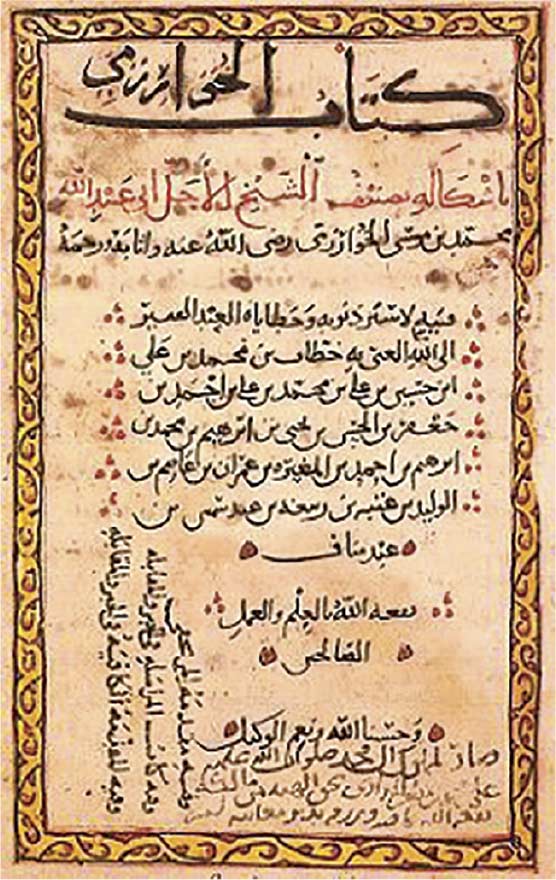
A page found in al-Khwarizmi’s mathematical work on algebra, The Compendious Book on Calculation by Completion and Balancing. Courtesy of The Oxford History of Islam, Oxford University Press.
Among the most important of these contributions was number theory and the system of Arabic numerals that we use today. These ideas originated in India and were translated and applied by Persian mathematician al-Khwarizmi in his work On the Calculation with Hindu Numerals, and by al-Kindi in his work On the Use of Indian Numerals.
Al-Khwarizmi was a scholar at the House of Wisdom in Baghdad, where he studied and translated Greek and Sanskrit scientific works. He was also a pioneer of algebra, which is named from the Latinization of the title of his book, specifically the word “al-jabr,” which means completion or rejoining. He also made significant contributions to trigonometry, for which he created accurate sine and cosine tables and the first table of tangents. Later translations of his work Latinized al-Khwarismi’s name to “Algorithmi,” from which we derive the words algorithm and algorism.
Ibn al-Haytham himself was a skilled mathematician, famously completing Apollonius of Perga’s Conics, reconstructing the lost eighth volume based on Apollonius’ observations in the other seven. A pioneer of analytic geometry, Ibn al-Haytham was also the first to apply algebra to geometry.
Without these contributions, many subsequent and future scientific discoveries in optics and beyond would never have been possible.